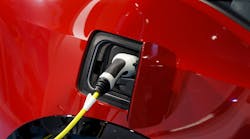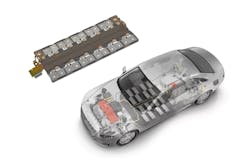This article is part of the TechXchange: EV Battery Management.
As the electric-vehicle (EV) era continues to take shape, cars are transforming into complex, high-voltage power systems.
To distribute power from the battery pack at the heart of the EV and then replenish it quickly and safely, the power electronics inside the system need to evolve to be smaller, lighter, and much more energy efficient.
But at the same time, auto giants are also looking more closely at the construction of the interconnects used to physically connect the cells in the battery to each other, to control units, and to other systems in the EV.
Bundling Batteries
Molex is playing its part with a novel cell contacting system called Volfinity. It bundles the battery cells into larger modules and sends signals to the EV’s main battery-management system (BMS), which carefully regulates the battery to maximize its power output and safety. The connectivity and electronics leader also said that BMW is using a customized Volfinity system in its next-generation EV class.
Developed in collaboration with plug-in hybrid EV and full-electric EV makers, energy-storage companies, and battery-cell and battery-pack suppliers, Molex said Volfinity offers a high-reliability interface solution. It’s used to connect cells to the control board in the EV battery module, taking the place of daisy-chained wires. The system integrates cell sensing features, cell monitoring and balancing, and temperature measurement functions. Plus, everything is designed to meet the functional-safety requirements of EVs.
The system uses Molex’s FPC connectors to relay temperature, voltage, and current data to the central BMS in the EV, while the copper busbars inside Volfinity form the +ve and -ve poles of the battery module.
Benefits of Higher Voltage
Most electric vehicles on the road operate with 400-V bus voltages, a significant step up from current 12- to 48-V systems, and 800-V systems are set to become the standard for EV battery packs in the future.
Increasing the EV’s operating voltage reduces the current flowing through the wiring harness, which automakers can shrink as a result. The minimized wiring harness also lowers the weight, which in turn, boosts the EV’s overall range per charge. Faster charging times are possible with higher voltages, which helps diminish losses due to resistance heating and, thus, takes a load off the EV’s cooling systems.
The company portrays the Volfinity solution as a single, large, shoebox-shaped connector—one small enough to fit under the hood of the EV without being so compact that it impedes easy cell removal and replacement.
Volfinity Features
A large plastic tray holds all of the building blocks of the new Volfinity system in place. Using plastic removes the risk of arcing and reduces weight. Aluminum busbars connect the battery cells in series or in parallel with thermal efficiency and mechanical flexibility. For safety, it is important to keep tabs on the heat generated by the cells that act as the building blocks of an EV battery module, and so, the Volfinity system attaches temperature sensors to each one.
The flexible FPC connectors that attach to the BMS are welded instead of wired to the aluminum busbar to better meet EV requirements, said Molex. Volfinity supports both prismatic and cylindrical battery cells.
These connectors also improve reliability—they lower the risk of manually wired connections vibrating out of place or becoming deformed due to bending or degrading due to heat, cold, and other rigors on the road.
On top of that, busbars tend to have greater power capacity and heat dissipation compared to traditional wires and cabling, which is important as power-conversion and distribution systems in the EV hit higher power levels.
The traction inverters at the heart of today’s EVs deliver tens of thousands of watts at a time from the battery to drive electric motors, which can operate at speeds of more than 20,000 rotations per minute (RPM).
Read more articles in the TechXchange: EV Battery Management.


